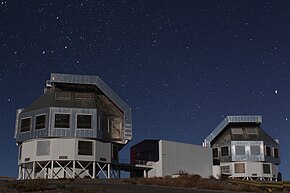 | |
| Alternative names | Walter Baade Magellan 6.5-m telescope (LCO) |
|---|---|
| Named after | Walter Baade, Landon T. Clay |
| Part of | Las Campanas Observatory |
| Location(s) | Atacama Region, Chile |
| Coordinates | 29°00′54″S 70°41′30″W / 29.015°S 70.6917°W |
| Organization | Carnegie Institution for Science |
| Altitude | 2,516, 2,392 m (8,255, 7,848 ft) |
| First light | 15 September 2001, 7 September 2002 |
| Telescope style | Gregorian telescope optical telescope |
| Number of telescopes | 2 |
| Diameter | 6.5 m (21 ft 4 in) |
| | |
The Magellan Telescopes are a pair of 6.5-metre-diameter (21 ft) optical telescopes located at Las Campanas Observatory in Chile. The two telescopes are named after the astronomer Walter Baade and the philanthropist Landon T. Clay. First light for the telescopes was on September 15, 2000 for the Baade, and September 7, 2002 for the Clay. A consortium consisting of the Carnegie Institution for Science, University of Arizona, Harvard University, the University of Michigan and the Massachusetts Institute of Technology built and operate the twin telescopes. The telescopes were named after the sixteenth-century Portuguese explorer Ferdinand Magellan.
The Giant Magellan Telescope (GMT) is an extremely large telescope under construction, as part of the US Extremely Large Telescope Program.[1]
- ^ Harvard & Smithsonian (6 February 2022). "Mission Critical: Giant Magellan Telescope Ranked a National Priority". SciTechDaily. Retrieved 7 February 2022.
